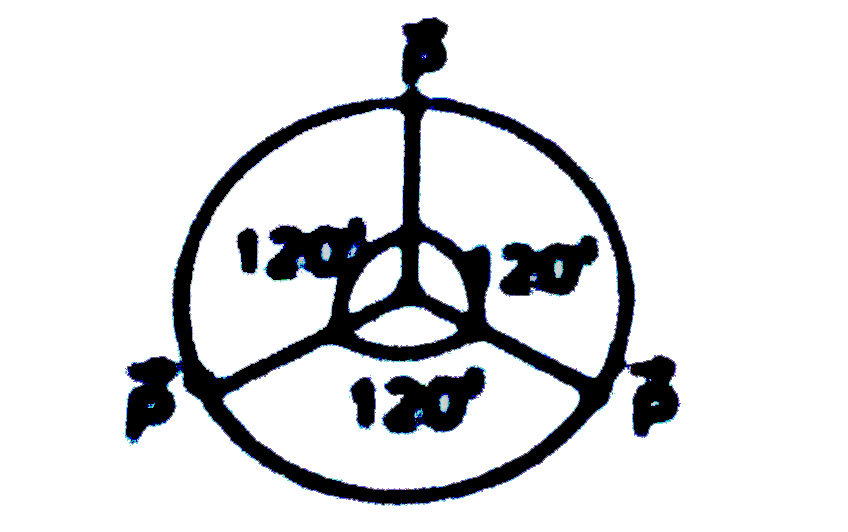A charge q is divided into three equal parts and placed symmetrically on a circle of radius r. The same charge is divided into four equal parts and placed symmetrically on the same circle. The electric field intensities at the centre of the circle in two situations are zero
Q. The ratio of electric potentials at the centre in the two situations is
2√3
11
43
169
To solve the problem, we need to find the electric potentials at the center of a circle for two different scenarios where a charge Q is divided into three equal parts and four equal parts, respectively.
1. Understanding the Charge Distribution:
- In the first case, the charge Q is divided into three equal parts. Each part will have a charge of Q3.
- In the second case, the charge Q is divided into four equal parts. Each part will have a charge of Q4.
2. Electric Potential Due to a Point Charge:
- The electric potential V at a distance r from a point charge q is given by the formula:
V=kqr
where k is Coulomb's constant (k=14πϵ0).
3. Calculating Electric Potential in Case 1:
- For the first case, we have three charges of Q3 placed symmetrically on the circle.
- The electric potential at the center due to one charge is:
V1=kQ3r
- Since there are three charges, the total electric potential Vtotal1 at the center is:
Vtotal1=3×V1=3×kQ3r=kQr
4. Calculating Electric Potential in Case 2:
- For the second case, we have four charges of Q4 placed symmetrically on the circle.
- The electric potential at the center due to one charge is:
V2=kQ4r
- Since there are four charges, the total electric potential Vtotal2 at the center is:
Vtotal2=4×V2=4×kQ4r=kQr
5. Finding the Ratio of Electric Potentials:
- Now we have:
Vtotal1=kQrandVtotal2=kQr
- The ratio of the electric potentials at the center in the two cases is:
Ratio=Vtotal1Vtotal2=kQrkQr=1
Final Answer:
The ratio of electric potentials at the center in the two situations is 1:1.
---
- In the first case, the charge Q is divided into three equal parts. Each part will have a charge of Q3.
- In the second case, the charge Q is divided into four equal parts. Each part will have a charge of Q4.
- The electric potential V at a distance r from a point charge q is given by the formula:
V=kqr
where k is Coulomb's constant (k=14πϵ0).
- For the first case, we have three charges of Q3 placed symmetrically on the circle.
- The electric potential at the center due to one charge is:
V1=kQ3r
- Since there are three charges, the total electric potential Vtotal1 at the center is:
Vtotal1=3×V1=3×kQ3r=kQr
- For the second case, we have four charges of Q4 placed symmetrically on the circle.
- The electric potential at the center due to one charge is:
V2=kQ4r
- Since there are four charges, the total electric potential Vtotal2 at the center is:
Vtotal2=4×V2=4×kQ4r=kQr
- Now we have:
Vtotal1=kQrandVtotal2=kQr
- The ratio of the electric potentials at the center in the two cases is:
Ratio=Vtotal1Vtotal2=kQrkQr=1
The ratio of electric potentials at the center in the two situations is 1:1.
Topper's Solved these Questions
Similar Questions
A charge q is divided into three equal parts and placed symmetrically on a circle of radius r. The same charge is divided into four equal parts and placed symmetrically on the same circle. The electric field intensities at the centre of the circle in two situations are zero
Q. The potential energy of the system in first situation where the charge is divided into three equals parts is
View SolutionA charge q is divided into three equal parts and placed symmetrically on a circle of radius r. The same charge is divided into four equal parts and placed symmetrically on the same circle. The electric field intensities at the centre of the circle in two situations are zero
Q. If a charge (part charge) is removed from one location in both the situations, the ratio of magnitudes of the electric field intensities at the centre is
View SolutionThree equal charges, each +q are placed on the corners of an equilatreal triangel . The electric field intensity at the centroid of the triangle is
View SolutionThree dipoles each of dipole moment of magnitude p are placed tangentially on a circle of radius R in its plae positioned at equal angle from each other as shown in the figure. Then the magnitude of electric field intensity at the centre of the circle will be :

View SolutionA conducting shell of radius R carries charge −Q. A point charge +Q is placed at the centre. The electric field E varies with distance r (from the centre of the shell) as
View SolutionA charge q coulomb moves in a circle at n revolution per second and the radius of the circle is r metre. Then magnetic feild at the centre of the circle is
View SolutionA charge q is uniformly distributed over a quarter circular ring of radius r. The magnitude of electric field strength at the centre of the ring will be
View SolutionA conducting shell of radius R carries charge–Q. A point charge +Q is placed at the centre of shell. The electric field E varies with distance r (from the centre of the shell) as :
View SolutionTwo charges e and 3e are placed at a distance r. The distance of the point where the electric field intensity will be zero is
View SolutionA solid conducting sphere of radius r is having a charge of Q and point charge q is a distance d from the centre of sphere as shown. The electric potential at the centre of the solid sphere is :

View Solution

